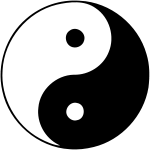 Yin and yang explains how opposites are part of a whole, how they interact and affect each other. The concept of yin and yang is fundamental and core to Chinese medicine as well as internal styles. Regardless of whether you believe in the concept and whether you can make use of this phenomenon to your advantage, this duality of nature exists.
Yin and yang explains how opposites are part of a whole, how they interact and affect each other. The concept of yin and yang is fundamental and core to Chinese medicine as well as internal styles. Regardless of whether you believe in the concept and whether you can make use of this phenomenon to your advantage, this duality of nature exists.
When talking about fighting styles, people generally value strength, speed, hard hits, etc without understanding the effectiveness of sensitivity and flow. Favoring one extreme in isolation is like choosing to possess half of a hundred dollar bill or having just dessert for dinner – ridiculous but you can actually find examples of that type of mentality. Personally, I love changes – I love the change of seasons; my personal lows make my personal highs feel so much better; I enjoy the variety life offers.
Some key points regarding yin and yang:
- Attributes like fast vs slow, hard vs soft, high vs low are not absolutes. What is most important is not their specific state but their dynamic balance and relationship.
- The balance and relationship between any of the key attributes / aspects exist within yourself, within your opponent as well as between the two of you. This relationship exist at a point in time as well as in sequence.
- Skills are tools and therefore should not dictate how you feel nor how you can execute your decisions. To be effective and real, you need both sides, not just one extreme.
- Over-extending yourself towards any one extreme for any extended period actually weakens you. As an example, being assertive is good. However, to be overly aggressive actually weakens you because people think you are crazy and won’t even bother listening. To be confident is good but over-confidence gets you into trouble. To be respectful is good but if you blindly follow without apply your own judgement, then it is bad. Training hard is good but not observing the recovery cycles actually holds you back.
- Staying in JUST the middle ground is not really honoring the yin / yang principle either. My definition of staying balance means that you have both – NOT the absence of both. Furthermore, this balancing act is dynamic and not static.
- Human are habitual animals. Without forcing ourselves to actively go through the process of thinking / experiencing both sides of the equation, we tend to jump to conclusions or stay with what is convenient.
Exercise (email me your answers and you can also comment via Facebook if you are ‘my friend’):
- Is there a difference between the term aspect versus attributes? Which one suits us better for our use?
- Define as many attributes / aspects as you can with its duality in the context of fighting and training. For each pair of opposites, explain briefly why /how they are important.
- Give me other examples on how over-extension or indulgence in just one extremity can get you into trouble.
- Describe how you can apply the yin / yang principle into sparring / push hands / training.
- What can you use from this discussion?
